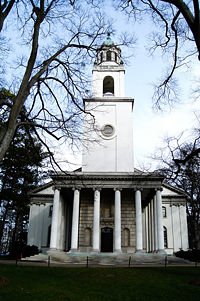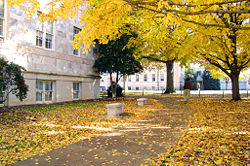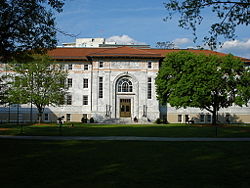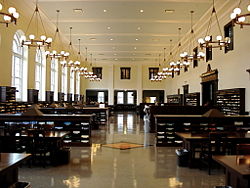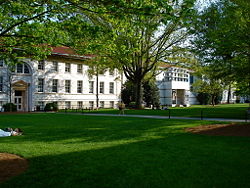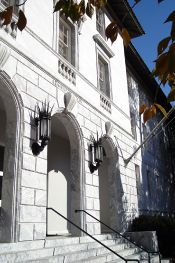Emory University
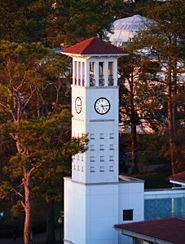
| |
| Motto | Cor prudentis possidebit scientiam (The wise heart seeks knowledge, [Proverbs 18:15]) |
|---|---|
| Established | 1836[1] |
| Type | Private |
| Location | metro Atlanta, Georgia USA |
| Website | http://www.emory.edu |
Emory University is a private university located in the metropolitan area of the city of Atlanta and in western unincorporated DeKalb County, Georgia, United States. Founded in 1836 and named after John Emory, a popular bishop of the Georgia Methodist Conference, the university consists of nine academic divisions including schools of arts and sciences, theology, business, law, medicine, public health, and nursing.
Mission and Reputation
Stated on the school's web site, the official mission statement of Emory University is: "To create, preserve, teach, and apply knowledge in the service of humanity."[2] The statement goes on to say that Emory strives to achieve this mission by keeping its focus of teaching and research in the core disciplines it has focused on since its founding.[3]
Emory University is one of the most well respected colleges in the United States. Emory University celebrated its sesquicentennial anniversary in 1986, when it featured a student body of about 8,500 undergraduate and graduate students. Emory is generally considered a shortlist member of the so-called "Southern Ivy League" and consistently ranks among the top universities in the United States. In 2004, Emory University's endowment was ranked 8th in the nation at an estimated $4.4 billion. The school is currently ranked 18th among national universities according to U.S. News & World Report[4]. However, it was not until recently that Emory started to have a well-established name recognition across the U.S. While always known for excellence in the regional South, its enrollment of students from other regions remained low until the beginning of the 21st century when it started to actively market itself beyond the South.
History
On December 10 1836, the Georgia General Assembly granted the Georgia Methodist Conference a charter to establish a college to be named for John Emory, a popular bishop who had presided at the 1834 conference but was killed in 1835 from a carriage accident. In 1837, at its first meeting, the Board of Trustees accepted land belonging to and to establish both a "contemplated college" and a proposed new town of Oxford, Georgia. By 1838, Emory College began admitting students.[5] For the duration of the nineteenth century, Emory College remained a small institution which offered students both a classical curriculum and professional training. Its students studied four years of Greek, Latin, and mathematics and devoted three years to the English Bible and the sciences of geography, astronomy, and chemistry. In 1875, the first laboratory-based studies for students commenced, alongside a rise of activity by the college's debating societies. Such debates included the justifiability of war, women's suffrage, the morality of slavery, and prohibition.
Emory College was closed briefly during the American Civil War. In the autumn of 1861, academic activity almost completely ceased when many of the students left to fight in the conflict. During the war, the college's buildings saw duty both as a Confederate hospital and Union headquarters. The school's library and other archives were destroyed. It was not until the summer of 1865 that the campus was able to fully return to its academic functions. By that time the campus was largely in shambles and the college's small endowment was depleted.[5]
In the years following the Civil War, Emory, along with the rest of the South, struggled to overcome financial devastation. A key moment came in 1880, when Emory president Atticus G. Haygood preached a Thanksgiving Day sermon declaring that slavery had been evil and urging southerners to cultivate industrial growth. The printed sermon was read by George I. Seney, a New York banker and Methodist, who responded by giving Emory College $5,000 to repay its debts, $50,000 for construction, and $75,000 to establish a new endowment—enormous sums for the time.[5]
Emory remained small and financially limited for the next thirty years. In 1913, Bishop Warren A. Candler, a former Emory College president, persuaded the Methodist Episcopal Church, South to make Emory the nucleus of a new university. The General Conference, eager to establish a Methodist university with a school of theology, decided to charter one university east of the Mississippi River and one to the river's west.[5]
In light of these developments, Emory College was rechartered by DeKalb County on January 25, 1915, as Emory University, which explains both the dates 1836 and 1915 sometimes featured on the school's seal. Henry Hornbostel was chosen to design many of the buildings on Emory University's new campus. His designs incorporated local stone and materials in the Georgia marble and red terracotta tile of the structures, which established the institution's unique architectural character. Emory University first opened its theology and law schools on the new campus quadrangle.
In 1919, Emory College moved from Oxford to DeKalb County. Emory University later added graduate, business, medical, public health, nursing, and dental schools. The Emory Dental School has since been closed. Doctoral studies at Emory University were established in 1946, and the school has continued to strengthen its graduate and professional schools since. In 1949, Alben Barkley returned to Emory to receive an honorary LLD degree and give the commencement address, the first Emory event to be televised.
Formerly an all-male school, in 1953 Emory opened its doors to women. Sororities soon followed, and first appeared in 1959. In 1962, in the midst of the American Civil Rights Movement, Emory embraced the initiative to end racial restrictions when it asked the courts to declare portions of the Georgia statutes unconstitutional. Previously, Georgia law denied tax-exempt status to private universities with racially integrated student bodies. The Supreme Court of Georgia ruled in Emory's favor and Emory became officially racially integrated.
Facilities
Programs
Colleges/Departments/Institutes
Approximately half of its students are enrolled in the undergraduate program and the other half are enrolled in one of Emory University's seven graduate programs. Its nine academic divisions include:
- College of Arts and Sciences; formerly known as Emory College (1836 - 2008)[6]
- Oxford College
- Graduate School; formerly known as Graduate School of Arts and Sciences (1919-2008)[7]
- Candler School of Theology
- Goizueta Business School
- Emory University School of Law
- Emory University School of Medicine
- Rollins School of Public Health
- Nell Hodgson Woodruff School of Nursing
In addition to its nine schools, the university encompasses The Carter Center, Yerkes National Primate Research Center and Emory Healthcare, Georgia's largest and most comprehensive healthcare system.[citation needed]
Student life
Traditions
Traditions at Emory include Dooley, the "Spirit of Emory" and the unofficial mascot of the university. Dooley is a skeleton and is usually dressed in black. The name "Dooley" was given to the unofficial mascot in 1909. Each year in the spring, during Dooley's Week, Dooley roams Emory's campus flanked by bodyguards ("Dooley guards") and lets students out of class with unscheduled appearances in classrooms. He typically walks slowly with an exaggerated limp. A spokesperson amongst the bodyguards walks with him to deliver his messages as he never speaks himself. His identity is unknown and this is often fodder for campus gossip. He adopts the first name and middle initial of the University's current president. As such, Dooley's current full name is James W. Dooley, after James W. Wagner. Dooley's Week culminates with Dooley's Ball, a grand celebration that takes place in the center of campus on McDonough Field held in celebration of Dooley and Emory University. A sporting match called the Dooley Cup is played between the university administration and the student government association (SGA) each spring as well, and the SGA remains undefeated.
Fraternities on Emory's campus have existed, officially and unofficially, since 1840. Sororities first came to campus in 1959. For undergraduates, Greek life comprises approximately 30% of the Emory student population, with the Office of Greek Life at Emory University consisting of 12 Fraternities and 13 Sororities. For most students, student life includes involvement in one or more of the 320 campus organizations, which includes a nationally ranked chess team and nationally ranked debate team, the latter having won the NDT in 2007, 2000, and 1996 (the Barkley Forum). The organizations give students opportunities to explore cultural, political, and social outlets, as well as allow them to voice collective concerns on current events and issues. Approximately 40% of students study abroad during their careers at Emory. More than 100 students work for the University's award-winning student newspaper The Emory Wheel and many work for the school's other student publications, including The Hub, The Spoke, Emory Political Review, the Lullwater Review and the Black Star. Over 30% of undergraduates pursue independent research or work with faculty on research projects during their four years at Emory. Emory also has four secret societies—the D.V.S. Senior Honor Society, the oldest society, founded in 1902; Ducemus; the Order of Ammon; and the Paladin Society.
According to the school website, about 25% of Emory students volunteer with Volunteer Emory, Emory's umbrella community service group. For the 2004-2005 academic year, undergraduates put in over 5,000 hours of community service. Volunteer groups include the Green Park Society, which is dedicated to improving blighted parks and recreation areas in Atlanta. The Society was created in Fall 2004 in response to a lack of student-catered community service options. GPS has "adopted" Maddox Park in Atlanta's Bankhead area and Storza Woods in Piedmont Park. Green Park students clean, restore foliage, and build nature trails on weekends. Green Park won the 2005 Joel Gellar Humanitarians Award.
After graduation, 42% of undergraduates plan to continue to graduate/professional school; 30% of those pursue an MD; and 20% plan to pursue a JD. Emory College has produced 18 Rhodes Scholars and 10 Marshall Scholars. In terms of class size, two-thirds of all Emory College classes have fewer than 20 students; 7% have more than 50.
Since the 1960s, Emory's student body has become more regionally and ethnically diverse. According to the school's website, more than 50% of its students are from outside the South, with about 30% from either the mid-Atlantic or northeast United States. Within Emory College's Class of 2012, 43% identify themselves as a member of one or more minority group. Thirty-one percent of the students are Asian, 8.7% African American and 3.5% Hispanic. Since the early 1990s, Emory has also been one of a few Southern universities to include sexual orientation in its non-discrimination policy. The school offers benefits to the domestic partners of gay and lesbian students, staff and faculty. In addition, the campus features centers devoted to female students, Jewish students, international students, multicultural students, and LGBT students.
As of 2006, tuition, room, and board for the school totals at about $40,000 a year. According to the Princeton Review, 38% percent of undergraduates receive need-based financial aid and the average freshman aid package for those receiving aid is $21,616.
Notable alumni
Organization
The College of Arts and Sciences is the undergraduate institution of Emory University with 66 majors, 53 minors, 17 joint concentrations, and 10 interdepartmental programs leading to a bachelor's degree. It enrolls approximately 6,000 undergraduate students. The Oxford College of Emory University, located in Oxford, Georgia, enrolls about 700 students. Students at Oxford traditionally complete their first two years of their degree at Oxford and then continue at the College of Arts and Sciences (located on the Atlanta campus) to complete their bachelor's degrees. Because of its size, Oxford College provides low student-teacher ratios in classrooms and a close-knit social community typical of liberal arts colleges.
The Graduate School has degree programs in 26 divisions in which students receive either master's or doctoral degrees. The Candler School of Theology is allied with the United Methodist Church, but enrolls students from many denominations. The Goizueta Business School was ranked 20th nationally by U.S. News and 18th by Forbes for their MBA program; the undergraduate program was ranked 4th by BusinessWeek in 2007. Emory Law School is currently ranked 22nd by U.S. News and World Report.
The Emory Healthcare System is the largest healthcare provider in Georgia and educates doctors, nurses, and other health professionals. The Emory University School of Medicine enrolls approximately 425 medical students, 1,000 residents and fellows, and 350 allied health students. Collaborating with the nearby Centers for Disease Control and Prevention and other public health organizations, the Rollins School of Public Health has about 800 graduate students. The Nell Hodgson Woodruff School of Nursing enrolls approximately 175 undergraduate students and 175 graduate students.
The Financial Aid Office awards need-based financial aid to all qualifying students through institutional and federal grant and loan packages. In January 2007, the University announced its newest aid program, Emory Advantage. Emory Advantage seeks to help undergraduate dependent students from families with assessed annual incomes $100,000 or less who demonstrate a need for financial aid. The program reduces the amount of money borrowed to pay for an undergraduate Emory degree. The goal is to make an Emory education attainable for any qualified student, regardless of income.
The Loan Replacement Grant (LRG] replaces loans for dependent undergraduate students whose families' assessed annual incomes are $50,000 or less. Grants replace need-based loans to cover expenses including tuition, room, and board. The eligible grant amount represents the student's self-help portion normally given in the form of a loan.
The Loan Cap Program (LCP) caps cumulative need-based debt at $15,000 for dependent undergraduate students whose families' assessed annual incomes are between $50,001 and $100,000. With the Loan Cap Program, students receive a standard financial aid award for freshman and sophomore years. This estimated award could include federal or state aid, institutional loans or grants, or Work-Study. After a student has accrued a total of $15,000 in need-based loans, Emory will provide grants to cover any remaining need-based funding incurred through degree completion.
Athletics
In 1897, Emory College became a pioneer with intramural sports. Emory's "athletics for all" program, which emphasizes the physical and social aspects of student development and learning, in addition to academic pursuits, soon rose to national prominence during the 1920s, prompting many other institutions to emulate it. In 1986, Emory formed the University Athletic Association (UAA) with seven other urban research universities—Carnegie Mellon University, Case Western Reserve University, Johns Hopkins University, New York University, University of Chicago, University of Rochester, and Washington University in St. Louis. Johns Hopkins University no longer participates in the UAA and Brandeis University has since joined. The UAA is sometimes referred to as the "Nerdy Nine" even though there are now only eight members.
The Emory gymnasium from 1945 was simply a converted World War II airplane hangar, with some renovations and modifications. However, in 1983 it was replaced by the new George W. Woodruff Physical Education Center (WoodPEC for short), built into the side of a hill opposite the old 1949 Alumni Memorial University Center building. By 1985, the Alumni Memorial University Center itself had been extended and remodeled into the R. Howard Dobbs University Center (the DUC for short). Today, the WoodPEC houses racquetball and tennis courts, an outdoor track and field, and a swimming pool.
Emory athletics today
Emory's sports teams are called the Eagles. They participate in the National Collegiate Athletic Association's Division III and the UAA. The eagle mascot of the university is named "Swoop." The previous Emory eagle logo, in use since the 1980s, was redesigned in 2005. To this day, the school fields no football team, prompting students to wear shirts that humorously claim that the Emory football team is "still undefeated."
Emory offers intercollegiate teams for men and women in cross country, swimming, tennis, track and field, basketball, and soccer, as well as golf and baseball for men, and volleyball and softball for women. The teams consistently top the UAA standings and are consistently ranked among the best in NCAA Division III, both regionally and nationally. Specifically, the swimming and diving team, according to the NCAA rankings, is considered to be one of the top programs in the nation. The men's tennis team placed first in the nation in 2003 and 2006, the women's tennis team placed first in 1996, 2003, 2004, 2005, and 2006, and the women's swimming and diving team placed first in 2005 and 2006. In 2003 and 2004, Emory finished second in the nation among more than 395 NCAA Division III schools in the NACDA Director's Cup for the best all-around athletic program. In golf Emory won three tournaments in the 2006 -2007 season, Rodrigo Olivero won back to back tournaments with 4 rounds under par setting new records. More recently, the Emory baseball team has emerged in prominence, finishing seventh in the nation in 2000, fifth in 2003, and second in 2007. According to 2008 pre-season polls, the team is ranked fifth in the nation.
Club sports, recreation, and intramural sports provide additional competitive opportunities. Club teams include crew, rugby, ultimate frisbee, roller hockey, lacrosse, racquetball, volleyball, sailing, and table tennis, among others. Emory's crew, ultimate frisbee and lacrosse teams have had considerable success and deserve particular note. Many intramural sports are also offered at Emory, ranging from basketball to dodgeball and from wrestling to golf, with flag football and soccer being the most popular. The student body participates heavily in athletics, with eighty percent of students participating in intercollegiate, club, recreation, or intramural sports sometime during their time at Emory. Many students also participate in the Outdoor Emory Organization (OEO)—an organization that sponsors weekend trips of outdoor activities, such as rafting, rock climbing and hiking.
Notable faculty
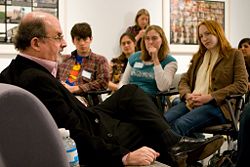
Notable faculty members at Emory have included:
- Jimmy Carter, former President of the United States, Nobel Laureate (2002) and University Distinguished Professor since 1982
- The Dalai Lama (Tenzin Gyatso), Nobel Laureate (1989) and Emory Presidential Distinguished Professor in 2007
- Elizabeth Fox-Genovese (died January 2007), a feminist American historian and a primary voice of the conservative women's movement
- Deborah Lipstadt, Professor of Modern Jewish and Holocaust Studies and author of Denying the Holocaust: The Growing Assault on Truth and Memory (1994)
- Jean-François Lyotard, late Robert Woodruff Professor and prominent French postmodernist philosopher
- Catherine Manegold (retired to write her second book in 2005), Pulitzer Prize-winning reporter as part of a team at The New York Times
- Sir Salman Rushdie, author and literary scholar
- Wole Soyinka, Nobel Laureate (1986) and author, former Distinguished Visiting Professor
- Natasha Trethewey, Pulitzer Prize-winning poet and Professor of English
- Desmond Tutu, Nobel Laureate (1984) and Anglican archbishop, past visiting professor of theology
- Frans de Waal, Charles Howard Candler Professor of Primate Behavior, foreign associate of the United States National Academy of Sciences
- Isabel Wilkerson, Pulitzer Prize-winner reporter and former New York Times correspondent
- Johnetta B. Cole, renowned African-American educator, former president of Spelman College and Bennett College
Notes
- ↑ Teodorescu, Daniel (2006-12-01). A Profile of Schools and Academic Resources (PDF). The Office of Institutional Research. Emory University. Retrieved 2007-05-30.
- ↑ (2008) Emory University:Office of the President ["University Mission Statement"] Retrieved October 18, 2008
- ↑ (2008) Emory University:Office of the President ["University Mission Statement"] Retrieved October 18, 2008
- ↑ (2008) U.S. News & World Report "Best Colleges 2009" Retrieved October 17, 2008
- ↑ 5.0 5.1 5.2 5.3 English, Thomas H. Emory University 1915–1965: A Semicentennial History (Atlanta: Emory University, 1966).
- ↑ [1]
- ↑ [2]
ReferencesISBN links support NWE through referral fees
- "Emory University," in New Georgia Encyclopedia. Retrieved July 1, 2006.
- "Emory University," in Encyclopedia of Southern Culture, ed. C. R. Wilson and William Ferris (Chapel Hill: University of North Carolina Press, 1989).
- English, Thomas H. Emory University 1915–1965: A Semicentennial History. Atlanta: Emory University, 1966.
- Gleason, Jan. "Emory ranked 9th-best national university by U.S. News & World Report magazine" in Emory Report 50, no. 1 (1997).
- Hauk, Gary S. A Legacy of Heart and Mind: Emory since 1836 (Atlanta: Emory University, developed and produced by Bookhouse Group, Inc., 1999).
- Young, James Harvey. "A Brief History of Emory University," in Emory College Catalog 2003–2005 (Atlanta: Emory University Office of University Publications, 2003), 9–15.
External links
| Association of American Universities | |
|---|---|
| Public | Arizona • Buffalo (SUNY) • UC Berkeley • UC Davis • UC Irvine • UCLA • UC San Diego • UC Santa Barbara • Colorado • Florida • Illinois • Indiana • Iowa • Iowa State • Kansas • Maryland • Michigan • Michigan State • Minnesota • Missouri • Nebraska • North Carolina • Ohio State • Oregon • Penn State • Pittsburgh • Purdue • Rutgers • Stony Brook (SUNY) • Texas • Texas A&M • Virginia • Washington • Wisconsin |
| Private | |
| Canadian | McGill • Toronto |
Credits
New World Encyclopedia writers and editors rewrote and completed the Wikipedia article in accordance with New World Encyclopedia standards. This article abides by terms of the Creative Commons CC-by-sa 3.0 License (CC-by-sa), which may be used and disseminated with proper attribution. Credit is due under the terms of this license that can reference both the New World Encyclopedia contributors and the selfless volunteer contributors of the Wikimedia Foundation. To cite this article click here for a list of acceptable citing formats.The history of earlier contributions by wikipedians is accessible to researchers here:
The history of this article since it was imported to New World Encyclopedia:
Note: Some restrictions may apply to use of individual images which are separately licensed.
